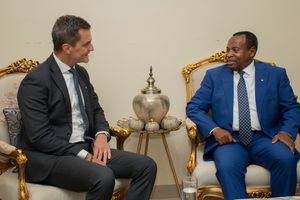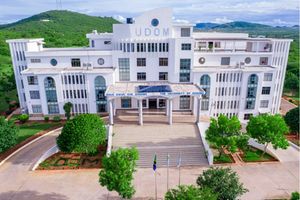Inside Tesla's graphite mining deal in Tanzania

Mining activities at the Bunyu Graphite Project. PHOTO | VOLT RESOURCES
After successful exploration in Ruangwa District of Lindi Region, graphite mining firm Uranex is now moving ahead with the construction phase.
In an interview with the country director of Uranex, that recently signed an agreement with American electric vehicle company Tesla to supply materials for manufacturing batteries, Peter Tsegas talks about the project’s potential and what it means to Tanzania’s economy.
Can you briefly tell us about Uranex?
Uranex is a subsidiary mining company fully owned by Magnis Energy Technologies of Australia and its Nachu Graphite Project in Ruangwa District, Lindi Region will become a well-recognised world-class graphite source.
What are your main activities in Tanzania?
The company is involved in the exploration and mining of graphite. It holds a special mining licence (SML) at a 30 square-kilometre area with huge deposits of high purity graphite, in the Nachu area in Ruangwa district, in the Lindi region. The company has been conducting exploration activities since 2013. It has now moved onto its construction phase.
The resources of the Nachu Graphite Project are expected to last 16 years, but more exploration shows us that it could last for the next 40 years. Some 230,000 tonnes of graphite concentrate are expected to be produced per year.
What are the expected economic impacts of Uranex in the country as a whole?
The project will have enormous benefits for Tanzania since graphite is one of the minerals of the future. Flake graphite is the dominant anode input for electric vehicle batteries, and the world is on the transition to cleaner sources of energy.
What is more, it will have its economic and financial benefits trickle down to surrounding communities and the country at large through the provision of services and products by Tanzanian companies and local suppliers in Ruangwa.
We are expecting the development of the project to create about 1,600 jobs locally, mostly benefiting Tanzanians.
It has been ten years since the beginning of the Nachu Graphite Project, how has it been going?
First, we started with exploration activities after acquiring all necessary licenses, permits and approvals from responsible government authorities.
Despite the Covid-19 pandemic, things have evolved and progressed. We are now in the construction phase of the project where the initial construction works have begun.
The project has resulted in land take and owners losing their homes and means of survival. How has the compensation process been?
The compensation process went very smoothly. Most of the 1,140 project affected people have been compensated, only a couple of them remain. An independent consultant was engaged to ensure that the compensation process met International Standards (IFC PS 5 as required by the World Bank). Also, the chief government valuer was involved to ensure that the process was fair.
In the first phase, those who will need to be resettled are having better and high-quality houses built for them. In total, 59 houses are being built on 56 plots on land purchased by Uranex. Those houses will be handed over to the PAP’s at the time of the relocation. These will cater for the people who have houses in the SML.
The area is not heavily populated, so few people had permanent structures on the site.
Resettlement has been a major issue; how has it been going?
As I said earlier, the area was not heavily populated, so it will be easy to relocate the people to the resettlement village. In the next phases, we are planning to provide social services such as schools, health facilities, and marketplace amongst others.
In terms of job creation and skills development, how has the local community benefited?
We have always endeavored to provide jobs to people in the surrounding local communities when there are openings. In terms of skills development, we are planning to provide training on farming activities and additional activities such as welding, mechanic, seam stressing to enable the surrounding community to provide services and products to the project.
Also health and education is a principal requirement for the sustainability of the project.
Locally, we have seen Ruangwa grow tremendously. For instance, when the project was starting we used to receive basic supplies such as meat, chicken and vegetables from as far as Dar es Salaam, but now these products are sourced from within the surrounding communities. Uranex is proud to have been and will continue to be part of that growth.
Tell us about measures to control expected environmental and social impacts on the community?
During the development of the project, we will strive to use the cleanest source of energy available to reduce the impact on the environment and the surrounding communities. We have engaged discussions with the Tanzania Petroleum Development Corporation to construct a 90-kilometre natural gas pipeline from Mingoyo that will supply us with gas for our power plant.
We will also ensure that our trucks are fitted with LNG engines to reduce our carbon footprint on the environment.
What is more, our processing of graphite flakes does not require the use of hazardous and harsh chemicals, unlike the processing of many other minerals.
We will also try our best to mitigate the emission of dust in the areas surrounding the SML.
We have a mining closure plan, as per requirements of the Tanzanian legal framework, which will require us to restore the area once the project is completed.
What are the main challenges that you were facing?
The main challenge we faced is accessing finance for the development of the project due to several factors including market demand and there are many projects across the world which are looking for funding, it is a very competitive world.
Of course there are infrastructure challenges which we are addressing and together with the government seeking to build and upgrade a lot of the existing infrastructure.
Now that you have signed a big contract with Tesla, what should we look forward to in the Nachu Graphite Project?
The deal comes at a critical juncture for both companies while Tanzania as a country is set to benefit tremendously in terms of investment, new revenues, technology transfer, and creation of well paying, high quality employment to Tanzanians due to the inherent level of an extended value chain.
Definitely exciting times ahead as Tanzania gets recognition in the new graphite space and markets by major players in the green technology industry.




